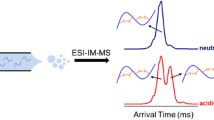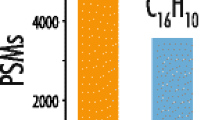Abstract
Disulfide bonds are critical linkages for maintaining protein structure and enzyme activity. These linkages, however, can limit peptide sequencing efforts by mass spectrometry (MS) and often require chemical reduction and alkylation. Under such conditions, information regarding cysteine connectivity is lost. Online partial disulfide reduction within the electrospray (ESI) source has recently been established as a means to identify complex cysteine linkage patterns in a liquid chromatography-MS experiment without the need for sample pre-treatment. Corona discharge (CD) is invoked as the causative factor of this in-source reduction (ISR); however, evidence remains largely circumstantial. In this study, we demonstrate that instrumental factors—nebulizing gas, ESI capillary material, organic solvent content, ESI spray needle-to-MS distance—all modulate the degree of reduction observed for the single disulfide in oxytocin, further implicating CD in ISR. Rigorous analysis of solution conditions, however, reveals that corona discharge alone can induce only minor disulfide reduction. We establish that CD-ESI of peptide solutions containing formic acid or its conjugate base results in a dramatic increase in disulfide reduction. It is also determined that ISR is exacerbated at low pH for complex peptides containing multiple disulfide bonds and possessing higher-order structure, as well as for a small protein. Overall, our results demonstrate that ESI of formate/formic acid–containing solutions under corona discharge conditions facilitates disulfide ISR, likely by a similar reduction pathway measured in γ-radiolysis studies nearly three decades ago.







Similar content being viewed by others
References
Fenn JB. Electrospray wings for molecular elephants (Nobel lecture). Angew Chem Int Ed. 2003;42:3871–94. https://doi.org/10.1002/anie.200300605.
Heck AJR, van den Heuvel RHH. Investigation of intact protein complexes by mass spectrometry. Mass Spectrom Rev. 2004;23:368–89. https://doi.org/10.1002/mas.10081.
Sharon M, Robinson CV. The role of mass spectrometry in structure elucidation of dynamic protein complexes. Annu Rev Biochem. 2007;76:167–93. https://doi.org/10.1146/annurev.biochem.76.061005.090816.
Vahidi S, Stocks BB, Konermann L. Partially disordered proteins studied by ion mobility-mass spectrometry: implications for the preservation of solution phase structure in the gas phase. Anal Chem. 2013;85:10471–8.
Boys BL, Kuprowski MC, Konermann L. Protein oxidative modifications during electrospray ionization: solution phase electrochemistry or corona discharge-induced radical attack? Anal Chem. 2009;81:4027–34. https://doi.org/10.1021/ac900243p.
Kumar M, Chatterjee A, Khedkar AP, Kusumanchi M, Adhikary L. Mass spectrometric distinction of in-source and in-solution pyroglutamate and succinimide in proteins: a case study on rhG-CSF. J Am Soc Mass Spectrom. 2012;24:202–12. https://doi.org/10.1007/s13361-012-0531-7.
Loo JA, Udseth HR, Smith RD. Collisional effects on the charge distribution of ions from large molecules, formed by electrospray-ionization mass spectrometry. Rapid Commun Mass Spectrom. 1988;2:207–10. https://doi.org/10.1002/rcm.1290021006.
Lloyd JR, Hess S. A corona discharge initiated electrochemical electrospray ionization technique. J Am Soc Mass Spectrom. 2009;20:1988–96. https://doi.org/10.1016/j.jasms.2009.07.021.
Ikonomou MG, Blades AT, Kebarle P. Electrospray mass spectrometry of methanol and water solutions suppression of electric discharge with SF6 gas. J Am Soc Mass Spectrom. 1991;2:497–505. https://doi.org/10.1016/1044-0305.
Kebarle P, Verkerk UH. Electrospray: from ions in solution to ions in the gas phase, what we know now. Mass Spectrom Rev. 2009;28:898–917. https://doi.org/10.1002/mas.20247.
Maleknia SD, Downard KM. Advances in radical probe mass spectrometry for protein footprinting in chemical biology applications. Chem Soc Rev. 2014;43:3244–58. https://doi.org/10.1039/c3cs60432b.
Buxton GV, Greenstock CL, Helman WP, Ross AB. Critical review of rate constants for reactions of hydrated electrons, hydrogen atoms and hydroxyl radicals (·OH/·O−) in aqueous solution. J Phys Chem Ref Data. 1988;17:513–886. https://doi.org/10.1063/1.555805.
Betz SF. Disulfide bonds and the stability of globular proteins. Protein Sci. 1993;2:1551–8. https://doi.org/10.1002/pro.5560021002.
Gorman JJ, Wallis TP, Pitt JJ. Protein disulfide bond determination by mass spectrometry. Mass Spectrom Rev. 2002;21:183–216. https://doi.org/10.1002/mas.10025.
Xia Y, Cooks RG. Plasma induced oxidative cleavage of disulfide bonds in polypeptides during nanoelectrospray ionization. Anal Chem. 2010;82:2856–64. https://doi.org/10.1021/ac9028328.
Stinson CA, Xia Y. Radical induced disulfide bond cleavage within peptides via ultraviolet irradiation of an electrospray plume. Analyst. 2013;138:2840–6. https://doi.org/10.1039/c3an00303e.
Kraj A, Brouwer H-J, Reinhoud N, Chervet J-P. A novel electrochemical method for efficient reduction of disulfide bonds in peptides and proteins prior to MS detection. Anal Bioanal Chem. 2013;405:9311–20. https://doi.org/10.1007/s00216-013-7374-3.
Nicolardi S, Deelder AM, Palmblad M, van der Burgt YE. Structural analysis of an intact monoclonal antibody by online electrochemical reduction of disulfide bonds and Fourier transform ion cyclotron resonance mass spectrometry. Anal Chem. 2014;86:5376–82. https://doi.org/10.1021/ac500383c.
Cramer CN, Kelstrup CD, Olsen JV, Haselmann KF, Nielsen PK. Complete mapping of complex disulfide patterns with closely-spaced cysteines by in-source reduction and data-dependent mass spectrometry. Anal Chem. 2017;89:5949–57. https://doi.org/10.1021/acs.analchem.7b00424.
Cramer CN, Kelstrup CD, Olsen JV, Haselmann KF, Nielsen PK. Generic workflow for mapping of complex disulfide bonds using in-source reduction and extracted ion chromatograms from data-dependent mass spectrometry. Anal Chem. 2018;90:8202–10. https://doi.org/10.1021/acs.analchem.8b01603.
Stocks BB, Melanson JE. In-source reduction of disulfide-bonded peptides monitored by ion mobility mass spectrometry. J Am Soc Mass Spectrom. 2018;29:742–51. https://doi.org/10.1007/s13361-018-1894-1.
Pei J, Hsu CC, Zhang R, Wang Y, Yu K, Huang G. Unexpected reduction of iminoquinone and quinone derivatives in positive electrospray ionization mass spectrometry and possible mechanism exploration. J Am Soc Mass Spectrom. 2017;28:2454–61. https://doi.org/10.1007/s13361-017-1770-4.
Elliot AJ, Sopchyshyn FC. The radiolysis of aqueous solutions containing dithiotreitol and oxidized dithiothreitol. Radiat Phys Chem. 1982;19:417–26. https://doi.org/10.1016/0146-5724(82)90131-5.
Elliot AJ, Simsons AS, Sopchyshyn FC. Radiolysis of solutions containing organo-disulphides. Radiat Phys Chem. 1984;23:377–84. https://doi.org/10.1016/0146-5724(84)90124-9.
Favaudon V, Tourbez H, Houée-Levin C, Lhoste J-M. CO2 ·- radical induced cleavage of disulfide bonds in proteins. A γ-ray and pulse radiolysis mechanistic investigation. Biochemistry. 1990;29:10978–89. https://doi.org/10.1021/bi00501a016.
Koch CJ, Raleigh JA. Radiolytic reduction of protein and nonprotein disulfides in the presence of formate: a chain reaction. Arch Biochem Biophys. 1991;287:75–84. https://doi.org/10.1016/0003-9861(91)90390-5.
Sun Y, Vahidi S, Sowole MA, Konermann L. Protein structural studies by traveling wave ion mobility spectrometry: a critical look at electrospray sources and calibration issues. J Am Soc Mass Spectrom. 2015;27. https://doi.org/10.1007/s13361-015-1244-5.
Chalkley RJ, Baker PR, Medzihradszky KF, Lynn AJ, Burlingame AL. In-depth analysis of tandem mass spectrometry data from disparate instrument types. Mol Cell Proteomics. 2008;7:2386–98. https://doi.org/10.1074/mcp.M800021-MCP200.
Li G, Yin Y, Huang G. Increased disulfide peptide sequence coverage via “cleavage on/off” switch during nanoelectrospray. RSC Adv. 2014;4:59650–4. https://doi.org/10.1039/c4ra12386g.
Abonnenc M, Qiao L, Liu B, Girault HH. Electrochemical aspects of electrospray and laser desorption/ionization for mass spectrometry. Annu Rev Anal Chem. 2010;3:231–54. https://doi.org/10.1146/annurev.anchem.111808.073740.
Zinck N, Stark AK, Wilson DJ, Sharon M. An improved rapid mixing device for time-resolved electrospray mass spectrometry measurements. ChemistryOpen. 2014;3:109–14. https://doi.org/10.1002/open.201402002.
Kanev IL, Mikheev AY, Shlyapnikov YM, Shlyapnikova EA, Morozova TY, Morozov VN. Are reactive oxygen species generated in electrospray at low currents? Anal Chem. 2014;86:1511–7. https://doi.org/10.1021/ac403129f.
Smith RD, Loo JA, Ogorzalek Loo RR, Busman M, Udseth HR. Principles and practice of electrospray ionization-mass spectrometry for large polypeptides and proteins. Mass Spectrom Rev. 1991;10. https://doi.org/10.1002/mas.1280100504.
Van Berkel GJ, Kertesz V. Using the electrochemistry of the electrospray ion source. Anal Chem. 2007;79:5510–20. https://doi.org/10.1021/ac071944a.
Liu Y-H, Konermann L. Conformational dynamics of free and catalytically active thermolysin are indistinguishable by hydrogen/deuterium exchange mass spectrometry. Biochemistry. 2008;47:6342–51. https://doi.org/10.1021/bi800463q.
Nshanian M, Lakshmanan R, Chen H, Ogorzalek Loo RR, Loo JA. Enhancing sensitivity of liquid chromatography-mass spectrometry of peptides and proteins using supercharging agents. Int J Mass Spectrom. 2018;427:157–64. https://doi.org/10.1016/j.ijms.2017.12.006.
Eshraghi J, Chowdhury SK. Factors affecting electrospray ionization of effluents containing trifluoroacetic acid for high-performance liquid chromatography/mass spectrometry. Anal Chem. 1993;65:3528–33. https://doi.org/10.1021/ac00071a035.
Li G, Pei J, Yin Y, Huang G. Direct sequencing of a disulfide-linked peptide with electrospray ionization tandem mass spectrometry. Analyst. 2015;140:2623–7. https://doi.org/10.1039/c5an00011d.
Wang W, Wang S, Liu F, Zheng W, Wang D. Optical study of OH radical in a wire-plate pulsed corona discharge. Spectrochim Acta, Part A. 2006;63:477–82. https://doi.org/10.1016/j.saa.2005.05.033.
Xu G, Chance MR. Hydroxyl radical-mediated modification of proteins as probes for structural proteomics. Chem Rev. 2007;107:3514–43. https://doi.org/10.1021/cr0682047.
Tong X, Wren JC, Konermann L. γ-ray-mediated oxidative labeling for detecting protein conformational changes by electrospray mass spectrometry. Anal Chem. 2008;80:2222–31. https://doi.org/10.1021/ac702321r.
Adams GE, Redpath JL, Bisby RH, Cundall RB. The use of free radical probes in the study of mechanisms of enzyme inactivation. Isr J Chem. 1972;10:1079–93. https://doi.org/10.1002/ijch.197200116.
Wu Z, Ahmad R, Armstrong DA. Formation of lipoamide anion radicals by hydroxyl, formate, and alcohol radicals at ph 6-9. Radiat Phys Chem. 1984;23:251–7. https://doi.org/10.1016/0146-5724(84)90116-X.
Raleigh JA, Koch CJ. Importance of thiols in the reductive binding of 2-nitroimidazoles to macromolecules. Biochem Pharmacol. 1990;40:2457–64. https://doi.org/10.1016/0006-2952(90)90086-Z.
Valentine SJ, Anderson JG, Ellington AD, Clemmer DE. Disulfide-intact and -reduced lysozyme in the gas phase: conformations and pathways of folding and unfolding. J Phys Chem B. 1997;101:3891–900. https://doi.org/10.1021/jp970217o.
Lee JW, Kim HI. Investigating acid-induced structural transitions of lysozyme in an electrospray ionization source. Analyst. 2015;140:661–9. https://doi.org/10.1039/c4an01794c.
Acknowledgements
The authors would like to thank Dr. Christopher Miles for helpful discussions.
Author information
Authors and Affiliations
Corresponding author
Ethics declarations
Conflict of interest
The authors declare that they have no conflicts of interest.
Additional information
Published in the topical collection Young Investigators in (Bio-)Analytical Chemistry with guest editors Erin Baker, Kerstin Leopold, Francesco Ricci, and Wei Wang.
Electronic supplementary material
ESM 1
(PDF 1557 kb)
Rights and permissions
About this article
Cite this article
Stocks, B.B., Melanson, J.E. Corona discharge electrospray ionization of formate-containing solutions enables in-source reduction of disulfide bonds. Anal Bioanal Chem 411, 4729–4737 (2019). https://doi.org/10.1007/s00216-018-1447-2
Received:
Revised:
Accepted:
Published:
Issue Date:
DOI: https://doi.org/10.1007/s00216-018-1447-2




